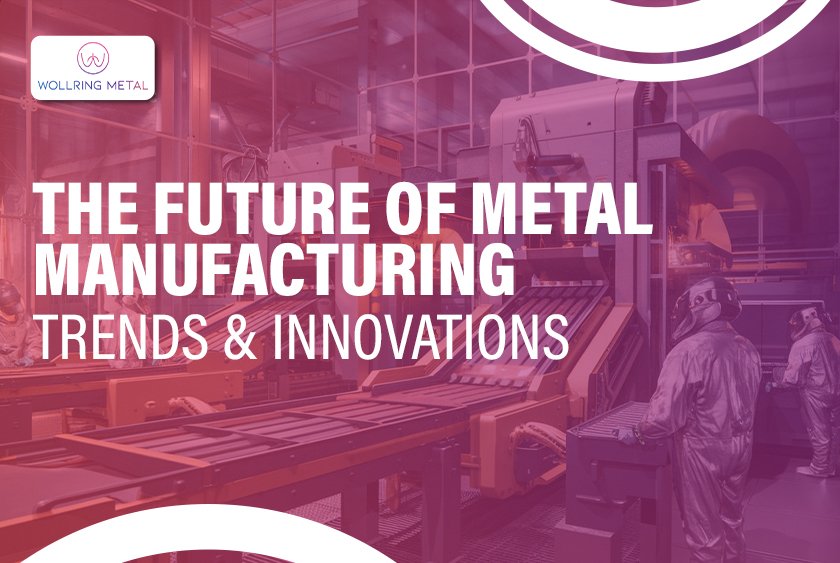The Future of Metal Manufacturing: Trends & Innovations
How does an industry born in fire and steel survive in an era of algorithms, sustainability mandates, and rapid automation?
It reinvents itself.
Metal manufacturing—often labelled traditional and unyielding—is quietly becoming one of the most dynamic sectors of industrial transformation. While the spotlight shines on AI, biotech, and EVs, the truth is: none of them can scale without metals. The future of metal production is no longer about physical strength alone—it's about precision, performance, and adaptability. And that’s changing everything.
Where Intelligence Meets Industry: Smart Manufacturing in Metals
In 2024, smart factories powered by edge analytics and industrial IoT accounted for over 25% of global metal production, according to McKinsey. Yet that’s just the beginning.
Smart manufacturing in metals is redefining productivity standards. Sensors track vibrations in real-time to predict machine fatigue. AI algorithms optimize heat treatment in milliseconds. Entire supply chains—from copper mines in Zambia to fabrication units in Germany—are being monitored, adjusted, and optimized with minimal human input.
Siemens recently deployed digital twins in its metal processing units, reporting a 20% decrease in energy consumption and a 15% boost in output efficiency within just two quarters.
This is no longer about enhancing what we have—it's about rethinking how we work altogether.
The Silent Disruptor: Advanced Metal Processing Is Changing the Rules
Advanced metal processing technologies—once reserved for aerospace—are now reshaping even basic consumer products.
Cold spray additive manufacturing, for instance, is enabling parts to be built without melting the metal, preserving microstructure integrity. This technique has seen a 40% increase in adoption across U.S. manufacturing sectors in the last three years. Meanwhile, laser cladding and friction stir welding are reducing material waste by nearly 35%.
The demand for precision is exploding. In industries like semiconductors and electric vehicles, micron-level tolerances aren’t optional—they’re mandatory.
This shift isn't cosmetic. It’s structural. It's how metal industry innovations are redefining performance boundaries, opening doors to materials that are lighter, stronger, and longer-lasting.
Metal Manufacturing Trends: The Green Steel Wave, Automation Tsunamis, and AI Mastery
The global metal sector is pivoting faster than ever—driven by policy, competition, and technology. Metal manufacturing trends today are a three-headed force of innovation:
- Green Steel Revolution: Sweden’s HYBRIT project became the world’s first to produce fossil-free steel, using hydrogen instead of coke. By 2030, green steel is expected to account for 10% of total global production, according to the IEA.
- AI & Automation Integration: Nearly 70% of global metal manufacturers are expected to use AI for process control and quality prediction by 2027, according to Deloitte’s Industry 4.0 Index.
- Data-Driven Decision-Making: Cloud-based ERP systems, digital twins, and blockchain are providing unparalleled transparency across production ecosystems.
These are no longer buzzwords. These are boardroom-level decisions redefining where the industry heads next.
A Real-World Case Study: Reinventing Relevance Through Innovation
Consider a European metals company—once struggling with inefficient batch processing and rising rejection rates. In 2022, they restructured their entire workflow by integrating advanced metal processing techniques like hot isostatic pressing and high-pressure die casting, paired with predictive AI for real-time analytics.
Results? Their delivery accuracy rose from 68% to 94%, material scrap dropped by 31%, and they unlocked three new long-term contracts with leading aerospace clients within 18 months.
This is the kind of reinvention the metal industry innovations now make possible. Not only survival—but dominance.
Building a Future on Data, Innovation, and Discipline
The future of metal production is shaped by more than technology. It’s built on discipline, systems, and unrelenting pursuit of excellence.
We’re entering an age where metals are no longer just raw materials—they're engineered outcomes. Performance alloys tailored for extreme conditions, lightweight composites replacing heavier counterparts, and digital control layers integrated deep into physical infrastructure.
And at the center of it all are companies who are bold enough to lead this transition—companies like Wollring Metal.
With its forward-facing mindset and investment in predictive analytics, process automation, and material innovation, Wollring is actively shaping what the future of metal production looks like. It doesn’t chase metal manufacturing trends—it sets them. From deep integration of AI to early adoption of sustainable metallurgy, WOLLRING has made one thing clear:
In tomorrow’s metal industry, leadership isn’t about size. It’s about vision.
